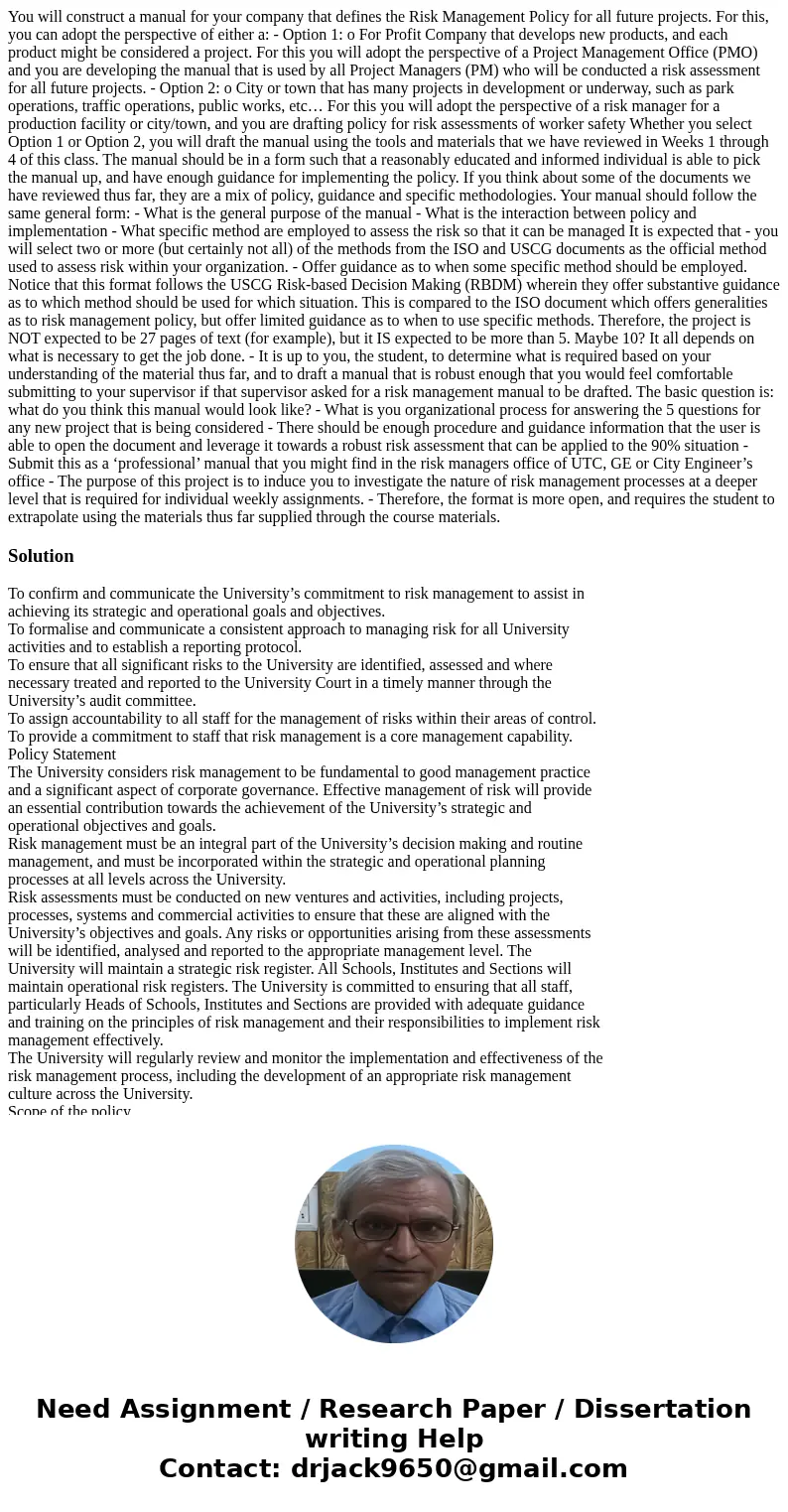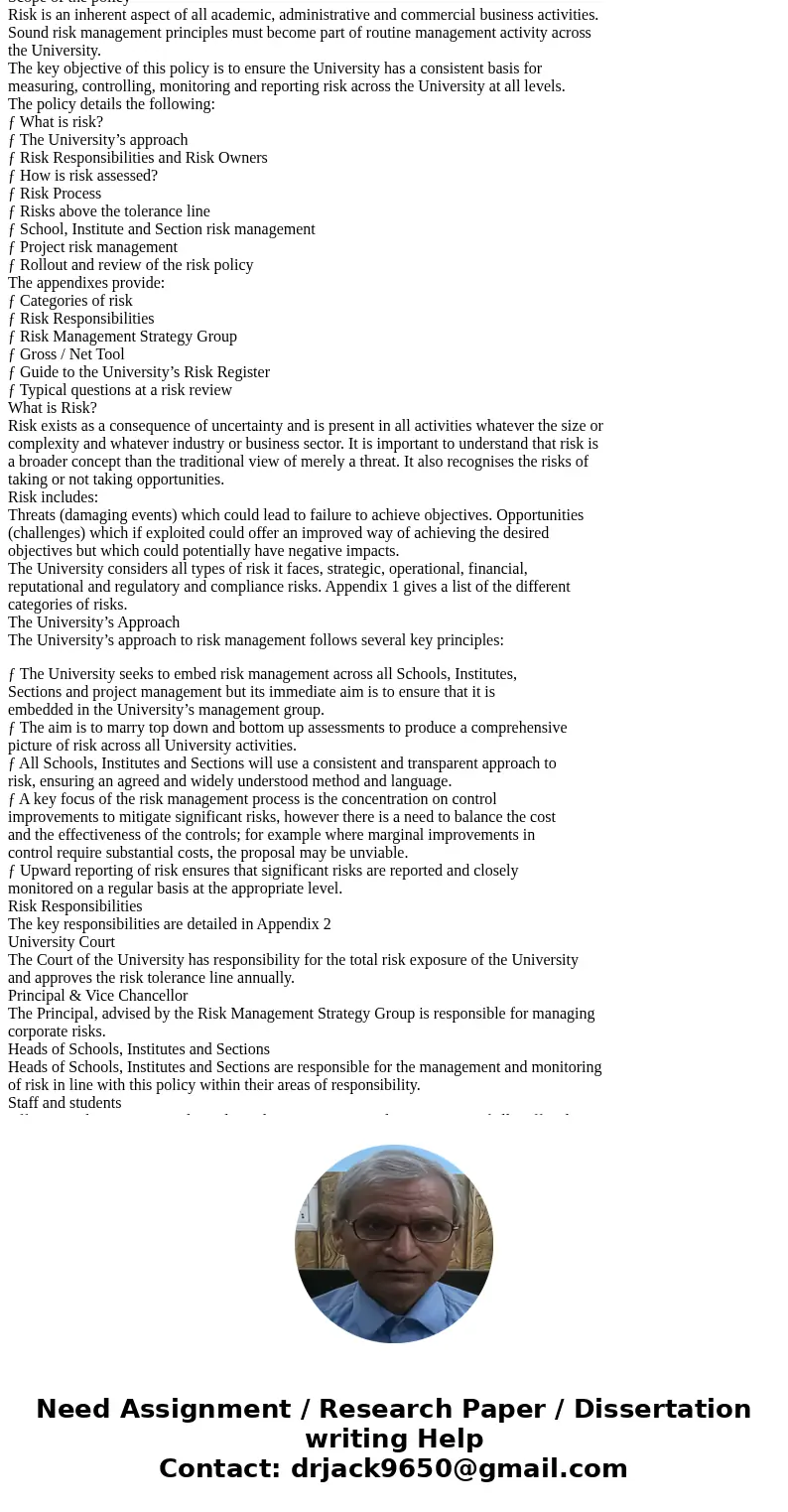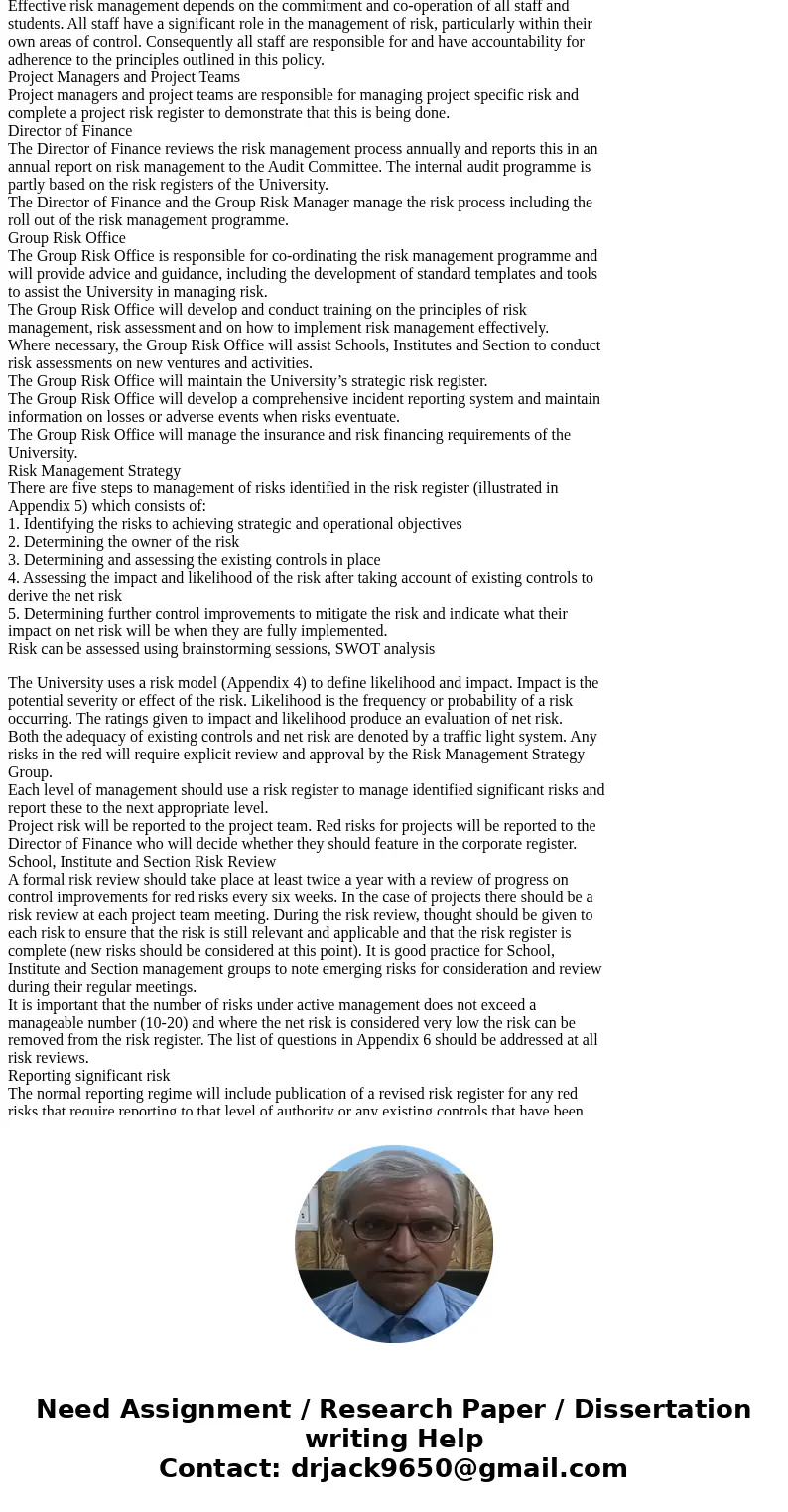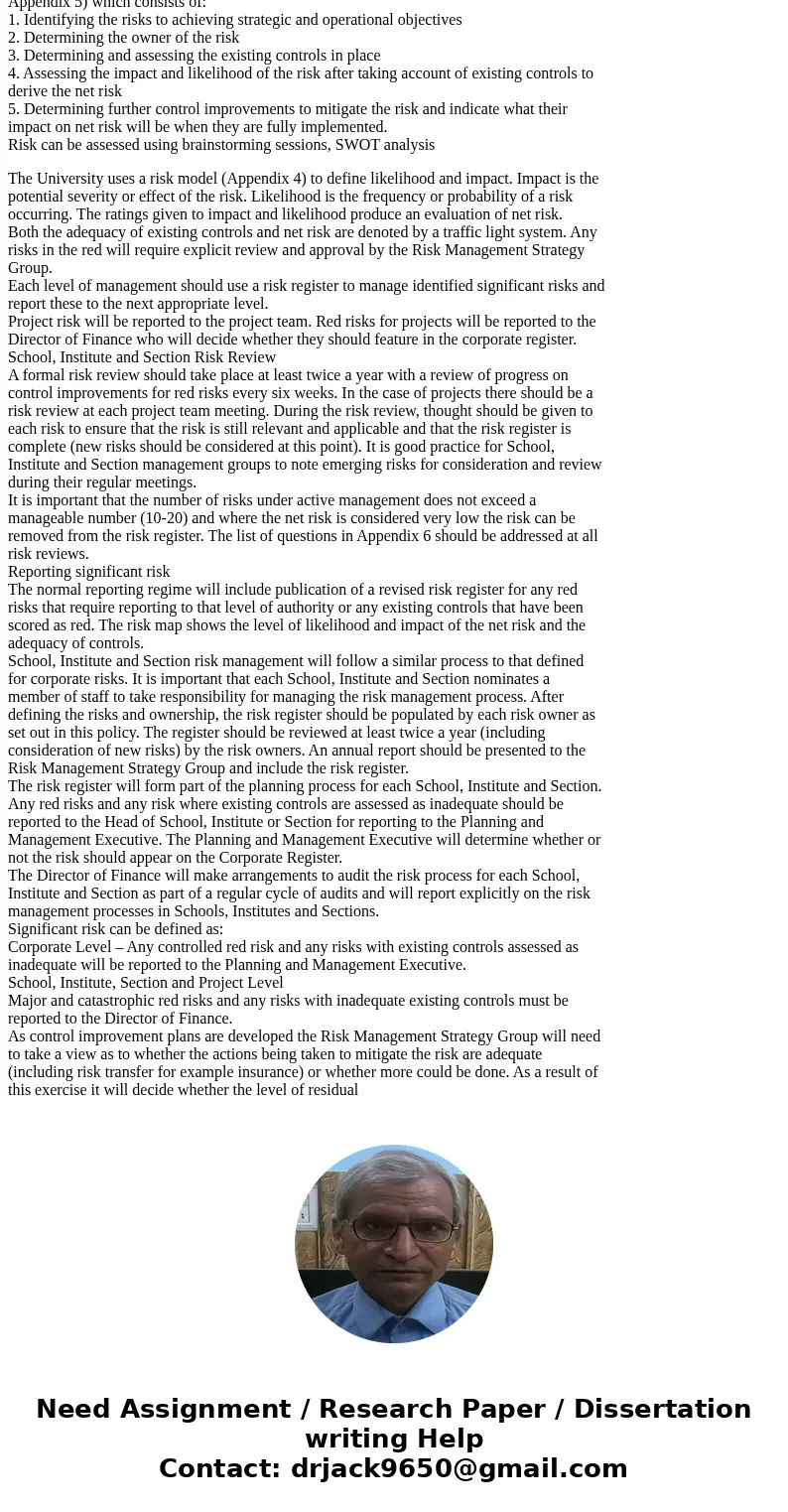You will construct a manual for your company that defines th
You will construct a manual for your company that defines the Risk Management Policy for all future projects. For this, you can adopt the perspective of either a: - Option 1: o For Profit Company that develops new products, and each product might be considered a project. For this you will adopt the perspective of a Project Management Office (PMO) and you are developing the manual that is used by all Project Managers (PM) who will be conducted a risk assessment for all future projects. - Option 2: o City or town that has many projects in development or underway, such as park operations, traffic operations, public works, etc… For this you will adopt the perspective of a risk manager for a production facility or city/town, and you are drafting policy for risk assessments of worker safety Whether you select Option 1 or Option 2, you will draft the manual using the tools and materials that we have reviewed in Weeks 1 through 4 of this class. The manual should be in a form such that a reasonably educated and informed individual is able to pick the manual up, and have enough guidance for implementing the policy. If you think about some of the documents we have reviewed thus far, they are a mix of policy, guidance and specific methodologies. Your manual should follow the same general form: - What is the general purpose of the manual - What is the interaction between policy and implementation - What specific method are employed to assess the risk so that it can be managed It is expected that - you will select two or more (but certainly not all) of the methods from the ISO and USCG documents as the official method used to assess risk within your organization. - Offer guidance as to when some specific method should be employed. Notice that this format follows the USCG Risk-based Decision Making (RBDM) wherein they offer substantive guidance as to which method should be used for which situation. This is compared to the ISO document which offers generalities as to risk management policy, but offer limited guidance as to when to use specific methods. Therefore, the project is NOT expected to be 27 pages of text (for example), but it IS expected to be more than 5. Maybe 10? It all depends on what is necessary to get the job done. - It is up to you, the student, to determine what is required based on your understanding of the material thus far, and to draft a manual that is robust enough that you would feel comfortable submitting to your supervisor if that supervisor asked for a risk management manual to be drafted. The basic question is: what do you think this manual would look like? - What is you organizational process for answering the 5 questions for any new project that is being considered - There should be enough procedure and guidance information that the user is able to open the document and leverage it towards a robust risk assessment that can be applied to the 90% situation - Submit this as a ‘professional’ manual that you might find in the risk managers office of UTC, GE or City Engineer’s office - The purpose of this project is to induce you to investigate the nature of risk management processes at a deeper level that is required for individual weekly assignments. - Therefore, the format is more open, and requires the student to extrapolate using the materials thus far supplied through the course materials.
Solution
To confirm and communicate the University’s commitment to risk management to assist in
achieving its strategic and operational goals and objectives.
To formalise and communicate a consistent approach to managing risk for all University
activities and to establish a reporting protocol.
To ensure that all significant risks to the University are identified, assessed and where
necessary treated and reported to the University Court in a timely manner through the
University’s audit committee.
To assign accountability to all staff for the management of risks within their areas of control.
To provide a commitment to staff that risk management is a core management capability.
Policy Statement
The University considers risk management to be fundamental to good management practice
and a significant aspect of corporate governance. Effective management of risk will provide
an essential contribution towards the achievement of the University’s strategic and
operational objectives and goals.
Risk management must be an integral part of the University’s decision making and routine
management, and must be incorporated within the strategic and operational planning
processes at all levels across the University.
Risk assessments must be conducted on new ventures and activities, including projects,
processes, systems and commercial activities to ensure that these are aligned with the
University’s objectives and goals. Any risks or opportunities arising from these assessments
will be identified, analysed and reported to the appropriate management level. The
University will maintain a strategic risk register. All Schools, Institutes and Sections will
maintain operational risk registers. The University is committed to ensuring that all staff,
particularly Heads of Schools, Institutes and Sections are provided with adequate guidance
and training on the principles of risk management and their responsibilities to implement risk
management effectively.
The University will regularly review and monitor the implementation and effectiveness of the
risk management process, including the development of an appropriate risk management
culture across the University.
Scope of the policy
Risk is an inherent aspect of all academic, administrative and commercial business activities.
Sound risk management principles must become part of routine management activity across
the University.
The key objective of this policy is to ensure the University has a consistent basis for
measuring, controlling, monitoring and reporting risk across the University at all levels.
The policy details the following:
ƒ What is risk?
ƒ The University’s approach
ƒ Risk Responsibilities and Risk Owners
ƒ How is risk assessed?
ƒ Risk Process
ƒ Risks above the tolerance line
ƒ School, Institute and Section risk management
ƒ Project risk management
ƒ Rollout and review of the risk policy
The appendixes provide:
ƒ Categories of risk
ƒ Risk Responsibilities
ƒ Risk Management Strategy Group
ƒ Gross / Net Tool
ƒ Guide to the University’s Risk Register
ƒ Typical questions at a risk review
What is Risk?
Risk exists as a consequence of uncertainty and is present in all activities whatever the size or
complexity and whatever industry or business sector. It is important to understand that risk is
a broader concept than the traditional view of merely a threat. It also recognises the risks of
taking or not taking opportunities.
Risk includes:
Threats (damaging events) which could lead to failure to achieve objectives. Opportunities
(challenges) which if exploited could offer an improved way of achieving the desired
objectives but which could potentially have negative impacts.
The University considers all types of risk it faces, strategic, operational, financial,
reputational and regulatory and compliance risks. Appendix 1 gives a list of the different
categories of risks.
The University’s Approach
The University’s approach to risk management follows several key principles:
ƒ The University seeks to embed risk management across all Schools, Institutes,
Sections and project management but its immediate aim is to ensure that it is
embedded in the University’s management group.
ƒ The aim is to marry top down and bottom up assessments to produce a comprehensive
picture of risk across all University activities.
ƒ All Schools, Institutes and Sections will use a consistent and transparent approach to
risk, ensuring an agreed and widely understood method and language.
ƒ A key focus of the risk management process is the concentration on control
improvements to mitigate significant risks, however there is a need to balance the cost
and the effectiveness of the controls; for example where marginal improvements in
control require substantial costs, the proposal may be unviable.
ƒ Upward reporting of risk ensures that significant risks are reported and closely
monitored on a regular basis at the appropriate level.
Risk Responsibilities
The key responsibilities are detailed in Appendix 2
University Court
The Court of the University has responsibility for the total risk exposure of the University
and approves the risk tolerance line annually.
Principal & Vice Chancellor
The Principal, advised by the Risk Management Strategy Group is responsible for managing
corporate risks.
Heads of Schools, Institutes and Sections
Heads of Schools, Institutes and Sections are responsible for the management and monitoring
of risk in line with this policy within their areas of responsibility.
Staff and students
Effective risk management depends on the commitment and co-operation of all staff and
students. All staff have a significant role in the management of risk, particularly within their
own areas of control. Consequently all staff are responsible for and have accountability for
adherence to the principles outlined in this policy.
Project Managers and Project Teams
Project managers and project teams are responsible for managing project specific risk and
complete a project risk register to demonstrate that this is being done.
Director of Finance
The Director of Finance reviews the risk management process annually and reports this in an
annual report on risk management to the Audit Committee. The internal audit programme is
partly based on the risk registers of the University.
The Director of Finance and the Group Risk Manager manage the risk process including the
roll out of the risk management programme.
Group Risk Office
The Group Risk Office is responsible for co-ordinating the risk management programme and
will provide advice and guidance, including the development of standard templates and tools
to assist the University in managing risk.
The Group Risk Office will develop and conduct training on the principles of risk
management, risk assessment and on how to implement risk management effectively.
Where necessary, the Group Risk Office will assist Schools, Institutes and Section to conduct
risk assessments on new ventures and activities.
The Group Risk Office will maintain the University’s strategic risk register.
The Group Risk Office will develop a comprehensive incident reporting system and maintain
information on losses or adverse events when risks eventuate.
The Group Risk Office will manage the insurance and risk financing requirements of the
University.
Risk Management Strategy
There are five steps to management of risks identified in the risk register (illustrated in
Appendix 5) which consists of:
1. Identifying the risks to achieving strategic and operational objectives
2. Determining the owner of the risk
3. Determining and assessing the existing controls in place
4. Assessing the impact and likelihood of the risk after taking account of existing controls to
derive the net risk
5. Determining further control improvements to mitigate the risk and indicate what their
impact on net risk will be when they are fully implemented.
Risk can be assessed using brainstorming sessions, SWOT analysis
The University uses a risk model (Appendix 4) to define likelihood and impact. Impact is the
potential severity or effect of the risk. Likelihood is the frequency or probability of a risk
occurring. The ratings given to impact and likelihood produce an evaluation of net risk.
Both the adequacy of existing controls and net risk are denoted by a traffic light system. Any
risks in the red will require explicit review and approval by the Risk Management Strategy
Group.
Each level of management should use a risk register to manage identified significant risks and
report these to the next appropriate level.
Project risk will be reported to the project team. Red risks for projects will be reported to the
Director of Finance who will decide whether they should feature in the corporate register.
School, Institute and Section Risk Review
A formal risk review should take place at least twice a year with a review of progress on
control improvements for red risks every six weeks. In the case of projects there should be a
risk review at each project team meeting. During the risk review, thought should be given to
each risk to ensure that the risk is still relevant and applicable and that the risk register is
complete (new risks should be considered at this point). It is good practice for School,
Institute and Section management groups to note emerging risks for consideration and review
during their regular meetings.
It is important that the number of risks under active management does not exceed a
manageable number (10-20) and where the net risk is considered very low the risk can be
removed from the risk register. The list of questions in Appendix 6 should be addressed at all
risk reviews.
Reporting significant risk
The normal reporting regime will include publication of a revised risk register for any red
risks that require reporting to that level of authority or any existing controls that have been
scored as red. The risk map shows the level of likelihood and impact of the net risk and the
adequacy of controls.
School, Institute and Section risk management will follow a similar process to that defined
for corporate risks. It is important that each School, Institute and Section nominates a
member of staff to take responsibility for managing the risk management process. After
defining the risks and ownership, the risk register should be populated by each risk owner as
set out in this policy. The register should be reviewed at least twice a year (including
consideration of new risks) by the risk owners. An annual report should be presented to the
Risk Management Strategy Group and include the risk register.
The risk register will form part of the planning process for each School, Institute and Section.
Any red risks and any risk where existing controls are assessed as inadequate should be
reported to the Head of School, Institute or Section for reporting to the Planning and
Management Executive. The Planning and Management Executive will determine whether or
not the risk should appear on the Corporate Register.
The Director of Finance will make arrangements to audit the risk process for each School,
Institute and Section as part of a regular cycle of audits and will report explicitly on the risk
management processes in Schools, Institutes and Sections.
Significant risk can be defined as:
Corporate Level – Any controlled red risk and any risks with existing controls assessed as
inadequate will be reported to the Planning and Management Executive.
School, Institute, Section and Project Level
Major and catastrophic red risks and any risks with inadequate existing controls must be
reported to the Director of Finance.
As control improvement plans are developed the Risk Management Strategy Group will need
to take a view as to whether the actions being taken to mitigate the risk are adequate
(including risk transfer for example insurance) or whether more could be done. As a result of
this exercise it will decide whether the level of residual




 Homework Sourse
Homework Sourse